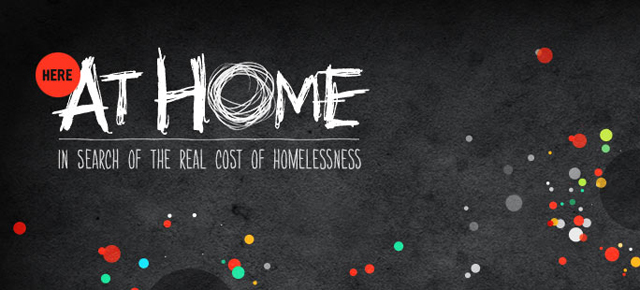
Here At Home: An Interactive Window into a Radical Canadian Experiment
Here At Home: An Interactive Window into a Radical Canadian Experiment
Most of us living in cities routinely cross paths with the homeless. Faced with their hardship, we can’t help but wonder: Who are these people? How did they end up on the street? And more importantly, what would they need to get back on their feet?
Enter Here At Home, our new web doc about a government pilot project that seeks to determine whether providing the homeless with a home first and treatment second (something known as the Housing First approach) is the best way to assist homeless people with mental health issues. From now until Summer 2013, 5 filmmakers will direct 42 short films in Moncton, Montreal, Toronto, Winnipeg and Vancouver to try to answer that question.
Here, Oisin Curran, web writer and social media manager for Here At Home, breaks down the project in 12 bite-size items. Read him and his fellow contributors on the Here At Home blog.
————————————————————————————————————————–
1. The experiment: Sometimes it’s referred to as a study, sometimes a “national research demonstration project,” sometimes a, “randomized controlled trial.” We just like to call it, “the experiment.”
2. The big idea: find the best way to help people who are homeless and have mental illness.
3. The method: At Home is experimenting with something called Housing First. The idea is, before you do anything else for homeless people with mental illness, get them housed. Then offer support services like psychiatric care, addiction counseling, job placement, etc.
4. What it’s not: old-school methods of helping this population typically use housing as a carrot – i.e. if you stop drinking, get off drugs and start taking meds for your mental illness, you get a home. The problem is, this approach has been used for decades and the population just keeps growing. Housing First, on the other hand, has an extremely successful track record when it comes to people staying housed.
5. The scale: At Home is HUGE. There are more than 2,000 participants. It’s the largest experiment of its kind in the world.
6. The breakdown: 1,265 of the participants have been housed by At Home; 970 have not. The experiment is comparing the two groups to see who does better and who costs the system less.
7. The map: It’s happening in 5 cities across Canada: Vancouver, Winnipeg, Toronto, Montreal and Moncton.
8. The masterminds: The Mental Health Commission of Canada is running it. Ottawa gave them $110 million to do the experiment.
9. The status quo: The homeless problem is expensive to ignore. Homeless people with mental illness spend a lot of time in hospitals, shelters, jails, courts… services paid for by various branches of government. In fact, it’s estimated that this particular population costs Canadian taxpayers around $1.4 billion. Just to be clear, that’s $1.4 billion for people to continue living on the street!
10. The bottom line: By most accounts Housing First is cost effective. It’s actually cheaper to house people and provide them with support services than it is to leave them on the street.
11. The timeframe: At Home enrolled its first participant in 2009; it ends in March of 2013.
12: The outcome: Unknown. Will the housed participants stay in their homes? Will the experiment kickstart a nationwide housing program? It all depends on the results…



